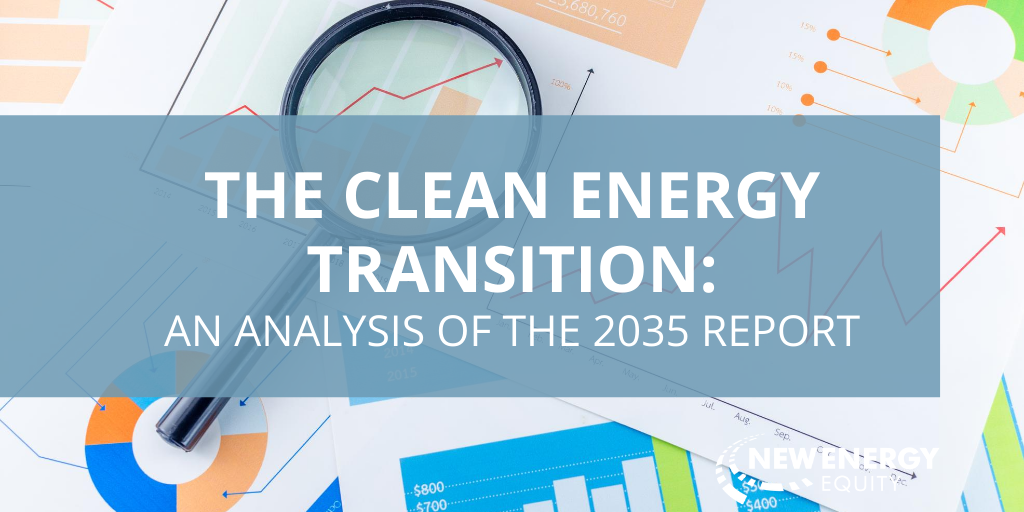New Energy Insights
- Home /
- New Energy Insights /
- The Clean Energy Transition: An Analysis of The 2035 Report
New Energy Equity (NEE) was founded with the purpose of driving the evolution of clean energy and leaving behind a better world. As a leader in the solar industry, our team often considers the greater implications of our work: most notably, how we are shaping the clean energy transition and continue to play a role in limiting domestic carbon emissions. We are committed to deploying as much solar as possible to help the U.S. de-carbonize its electricity sector, so when the newest research on our nation’s potential for achieving a predominantly carbon free-grid was released, we couldn’t wait to see what was in store.
In June, UC-Berkeley and GridLab released The 2035 Report —which showed that the United States can achieve 90% clean, carbon free electricity by 2035. The report develops two cases: the No New Policy case —which assumes the continuation of current state and federal policies and achieves 55% clean electricity by 2035, and the 90% Clean case which is driven by strong energy policy and requires that a 90% clean electricity share is reached by 2035.
Here is the energy mix breakdown presented in UC-Berkeley and Gridlab’s report. Under the 90% Clean case wind, solar, and batteries will provide 70% of annual generation during normal periods of energy generation and demand while hydropower and nuclear will provide 20%. The remaining 10% of the energy load will be met through existing nuclear and natural gas capacity. A crucial part of the 90% Clean case plans for the retirement of all existing coal plants by 2035 and does not require the build out of any new fossil fuel plants.
The How
Achieving 90% clean electricity in the United States in a mere 15 years would be an incredible feat and would require 1,100 GW of new wind and solar generation to be built, averaging about 70 GW per year. To put that into perspective, the U.S. added 13.3 GW of solar in 2019 and the wind industry added just over 9 GW to the grid. The increase in solar and wind deployment necessary to achieve the 90% Clean case is massive, but feasible. An accompanying report from Energy Innovation lays out a clear plan on how to achieve this wide-scale renewable deployment.
Research from Energy Innovation shows that to reach the 90% Clean case, a robust federal energy strategy must be developed. The Energy Innovation report suggests that a federal clean electricity standard reaching 55% clean electricity by 2025, 75% by 2030, 90% by 2035 and 100% by 2045 is necessary in order to meet the plan laid out in the 2035 report. Additionally, federal clean energy investment and production tax credits must be extended and transitioned to liquid incentives to the extent possible. Finally, these incentives must be applied to battery storage as well, since battery storage is key in providing clean energy during renewables’ off generation hours.
Another important policy piece necessary to achieve the 90% Clean case relates to the infrastructure upgrades necessary to support the huge increase in distributed generation resources. Researchers at Energy Innovation encourage a national effort to streamline renewable energy and transmission sitting along with strengthening federal authority to improve regional transmission, planning, and the distribution of interconnection costs. This sort of policy would certainly be welcome as soon as possible as developers like ourselves are often bogged down by interconnection delays and poor transmission processes.
The Why
There are a host of benefits and trickle-down effects that would come from achieving the 90% Clean case. The 90% Clean case reduces carbon dioxide (CO2) emissions by 88% by 2035. Additionally, it reduces fine particulate matter and sulfur dioxide emissions by 96% and 99% respectively. These drastic emissions reductions would result in $1.2 trillion in avoided health and environmental costs and 85,000 avoided premature deaths through 2050!
Another ancillary benefit of the 90% Clean case is that this path results in an additional 530,000 more jobs in the energy sector each year. The fact that the 90% Clean case results in a net increase in energy jobs is incredibly significant, especially considering that in the past, there has been a lot of push back against the renewable industry for creating job loss amongst energy workers in the oil and gas industries. Highlighting the fact that large scale renewable energy deployment will, on the aggregate, create jobs will be crucial in garnering support for the clean energy transition.
In addition to communicating the net gains in employment that will result from the clean energy transition, it will be important to support coal dependent communities that are directly hurt by the transition. This can be done by shoring up healthcare benefits and underfunded pensions, providing pathways for employment in the clean energy economy and by investing in local training programs.
The 2035 Report is especially ambitious as it shows that the timeline for the near complete de-carbonize of the electric sector can be accelerated from 2050 to 2035. The report is also incredibly insightful for its comparison between the No New Policy case and the 90% Clean case. The analysis presented in the report stresses the importance of concerted policy action. With the goals and pathways highlighted by the 2035 Report in mind, New Energy Equity will continue to support industry efforts pushing for ambitious federal energy goals, the extension of renewable and storage incentives, and the re-structuring of the interconnection process. NEE will continue to work tirelessly to deploy as much solar as our team can handle, with the goal of getting our nation one step closer to the 70 GW of new renewable energy necessary to be deployed annually in order to achieve our collective energy needs in a sustainable way.
Access the 2035 Report and supporting literature here.
How Can New Energy Equity Help You Reach Your Solar Goals?
Stay up-to-date with New Energy Equity by joining our mailing list.


